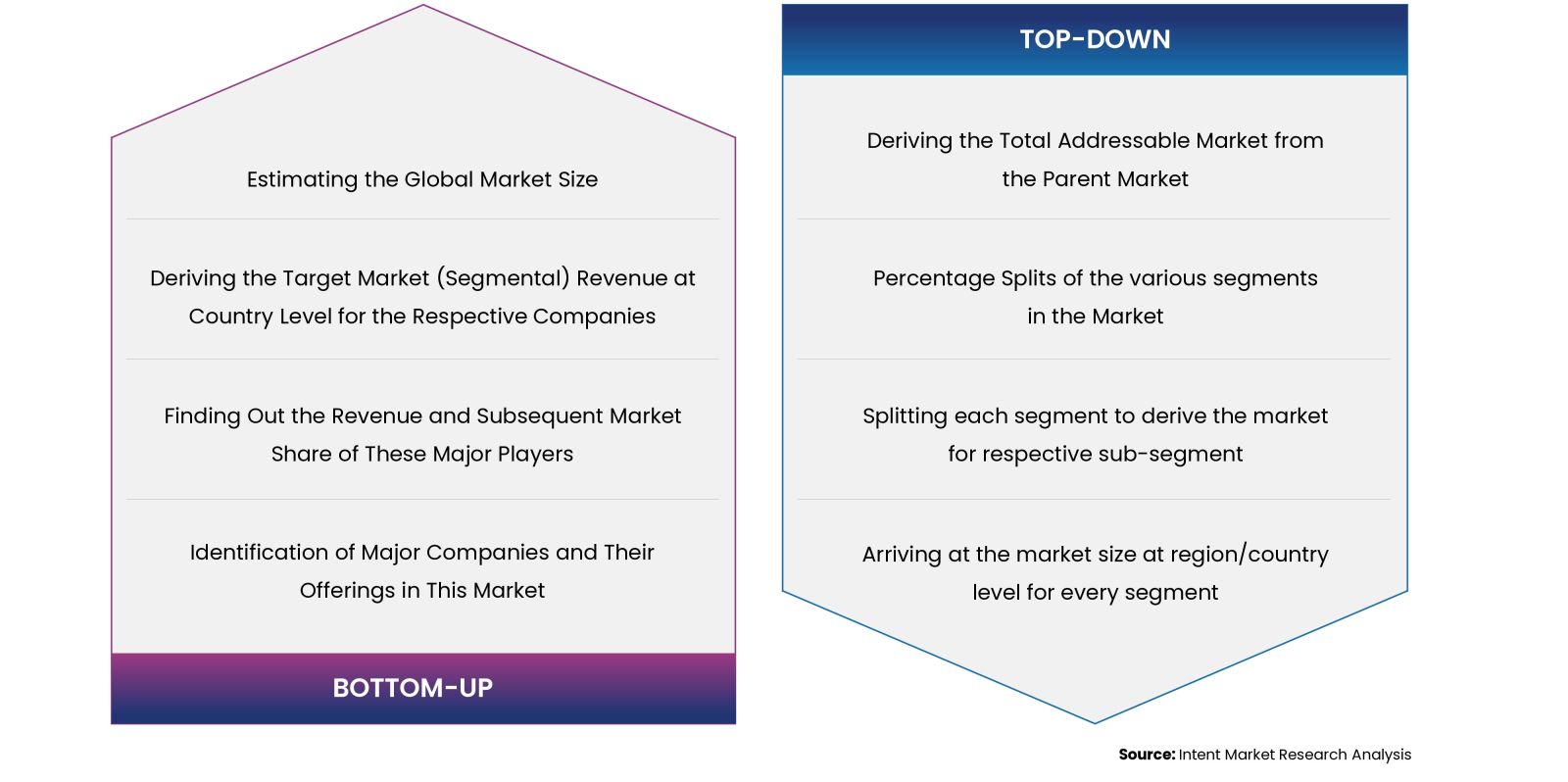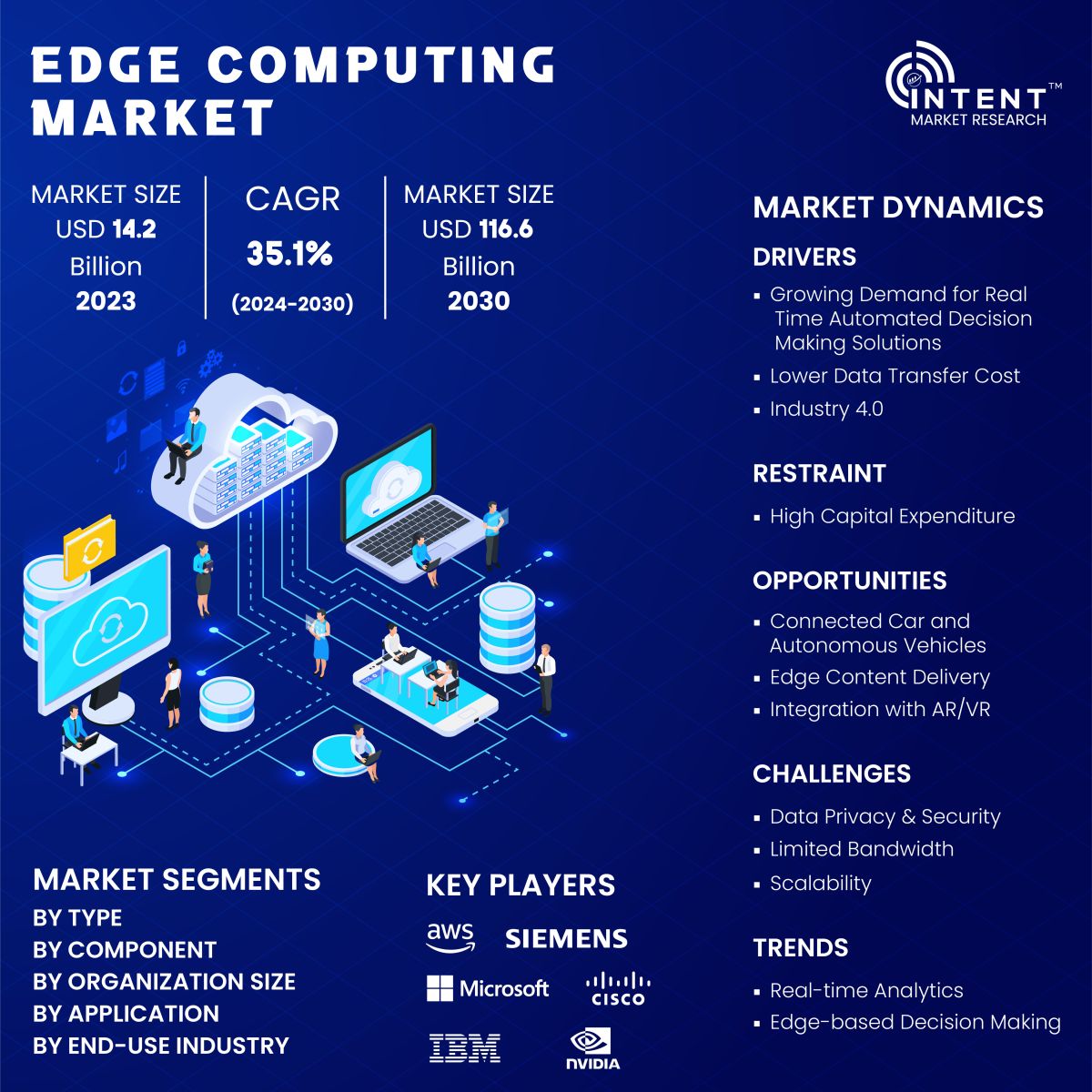The Edge Computing Market is expected to grow from USD 14.2 billion in 2023-e to USD 116.6 billion by 2030, at a CAGR of 35.1% during the forecast period. The edge computing market is a competitive market, the prominent players in the global market include AWS, Cisco, Dell, Google, HP, IBM, Microsoft, Nokia, Nvidia, Siemens, among others.
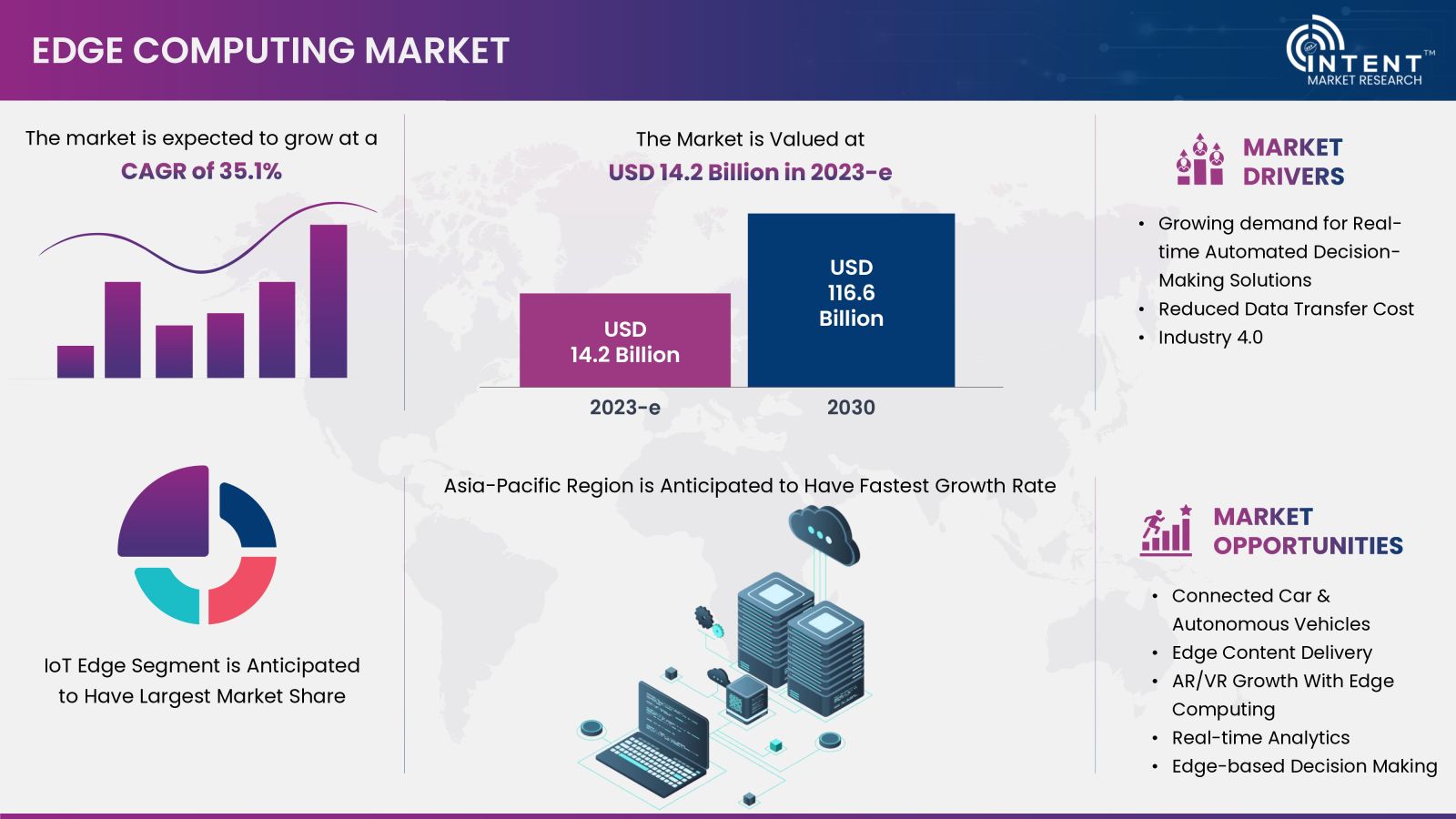
Edge computing is a decentralized computing architecture that positions enterprise applications in closer proximity to data sources, such as IoT devices or local edge servers. The proximity to data sources offers significant business advantages, including quicker insights, enhanced response times, and improved availability of bandwidth. The explosive growth of data generation across industries has faced the challenges of bandwidth and latency issues.
Edge computing significantly helps in reducing latency, addressing the delay in processing and transmitting data that can occur in traditional centralized computing architectures. It enables real-time processing and decision-making at the edge of the network, where data is generated. This is important for applications that require immediate responses, such as industrial automation, autonomous vehicles, and augmented reality.
Industry 4.0 Driving the Edge Computing Market
Industry 4.0 relies on the collection and analysis of vast amounts of data from sensors, machines, and production lines in real-time. Edge computing facilitates the processing of this data at the source, allowing for immediate insights and decision-making within manufacturing environments. Edge computing is a cornerstone of smart manufacturing, where connected devices, machines, and systems communicate and collaborate autonomously. Localized data processing at the edge enables real-time control, monitoring, and optimization of manufacturing processes.
Industry 4.0 emphasizes predictive maintenance to reduce downtime and enhance equipment reliability. Edge computing enables the analysis of sensor data locally, predicting potential equipment failures and allowing for timely maintenance interventions. The Industrial Internet of Things (IIoT) is a key component of Industry 4.0 and edge computing seamlessly integrates with IIoT devices, providing the necessary infrastructure for real-time data processing, analysis, and communication in industrial settings. The integration of edge computing into Industry 4.0 initiatives is pivotal for creating intelligent, connected, and efficient manufacturing environments.
Edge Computing Market Segment Insights
Real-time Decision Making Driving the Growth of IoT Edge Segment
IoT edge, which involves processing data closer to the source on IoT devices or gateways, is contributing significantly to the adoption and expansion of edge computing. IoT edge promotes the decentralization of data processing by enabling devices to perform local computation. This aligns with the fundamental principle of edge computing, which involves processing data closer to its source rather than relying solely on centralized cloud servers.
IoT edge enables real-time decision-making at the edge of the network, allowing devices to autonomously respond to local events and conditions. This is particularly important for applications such as predictive maintenance, where timely decisions can prevent equipment failures. The IoT edge segment is expected to show significant growth during the forecast period.
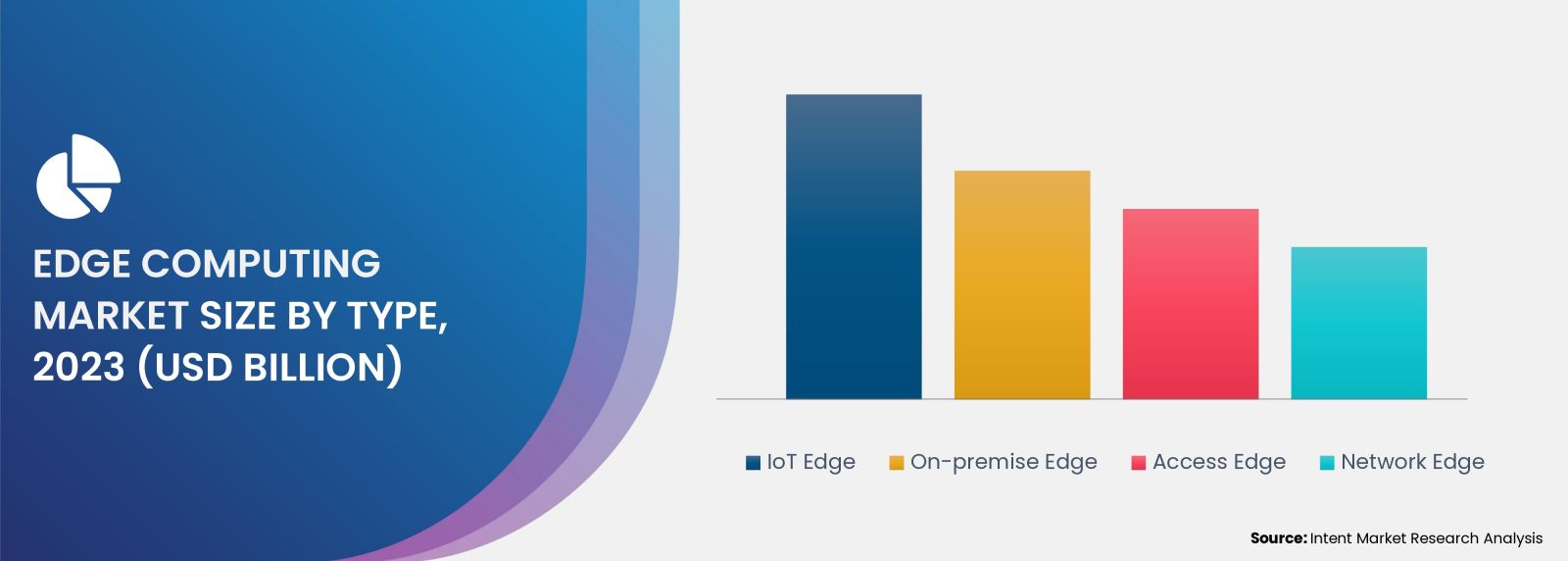
Increasing Adoption of IoT Devices Promoting the Growth of Hardware Segment
The widespread adoption of IoT devices across various industries, including smart homes, industrial automation, healthcare, and smart cities, has led to a surge in the data volume generated at the edge. Edge computing hardware is essential for processing this data locally, reducing the need for centralized cloud processing.
Edge computing hardware caters to a diverse range of edge devices, including sensors, cameras, gateways, and industrial machines. The hardware is designed to accommodate the specific requirements of different devices, ensuring compatibility and efficient processing. The increasing adoption of IoT devices drives the edge computing hardware, thereby driving the market growth.
SMEs Poised to Adopt Edge Computing to Improve their Efficiency
Edge computing offers several benefits for small and medium-sized enterprises (SMEs) across various industries. While large enterprises often lead in the adoption of advanced technologies, SMEs can also leverage edge computing to enhance their operations, improve efficiency, and stay competitive. Edge computing brings processing capabilities closer to the data source, reducing the latency associated with transmitting data to centralized cloud servers. This is particularly beneficial for SMEs requiring real-time or near-real-time processing, such as in retail, manufacturing, and customer service.
Edge computing can lead to cost savings for SMEs by reducing the need for extensive cloud infrastructure and minimizing data transfer costs. Localized processing at the edge means less reliance on expensive centralized servers, making it a cost-effective solution.
Surveillance Application Segment to show Significant Growth Potential
Edge computing plays a crucial role in enhancing surveillance systems by bringing computational capabilities closer to the source of data generation. This is particularly valuable in video surveillance applications where real-time processing, reduced latency, and efficient handling of large amounts of data are essential. Edge computing reduces latency in surveillance systems by processing video data locally at the edge. This is critical for applications where quick response times are crucial, such as in security monitoring, crowd management, and critical infrastructure protection.
Focus on Automation is Expected to Drive Manufacturing Industry Share
Edge computing in manufacturing refers to the deployment of computing resources closer to the point of data generation and processing within manufacturing environments. This approach is integral to Industry 4.0 initiatives, aiming to make manufacturing processes smarter, more efficient, and more responsive.
Edge computing supports predictive maintenance by analyzing data from sensors on machinery and equipment locally. This allows manufacturers to anticipate potential equipment failures, schedule maintenance proactively, and minimize downtime. Edge computing is essential for the deployment of autonomous systems and robotics in manufacturing. Localized decision-making on the shop floor enhances the autonomy of robots, cobots (collaborative robots), and automated guided vehicles (AGVs).
By processing data closer to the source, manufacturers can unlock new capabilities that contribute to competitiveness, flexibility, and responsiveness in the Industry 4.0 era. The manufacturing segment is expected to show substantial growth during the forecast period.
Asia-Pacific to Grow Exponentially Over the Forecast Period with Increasing Adoption in Smart Cities
The region is experiencing rapid urbanization, leading to the development of smart cities. Edge computing is fundamental to the implementation of smart city technologies, including intelligent transportation systems, public safety, and energy management. The deployment of 5G networks in several Asia-Pacific countries is a significant driver for edge computing growth. The low latency and high bandwidth of 5G enhance the capabilities of edge computing, making it more feasible for applications that demand real-time processing.
The Asia-Pacific region, known for its manufacturing industries potential, is actively embracing Industry 4.0 concepts. Edge computing is integral to smart manufacturing, supporting real-time monitoring, predictive maintenance, and enhanced automation in factories. Considering the potential of the region, the edge computing market in Asia-Pacific is estimated to record a significant growth during the forecast period.
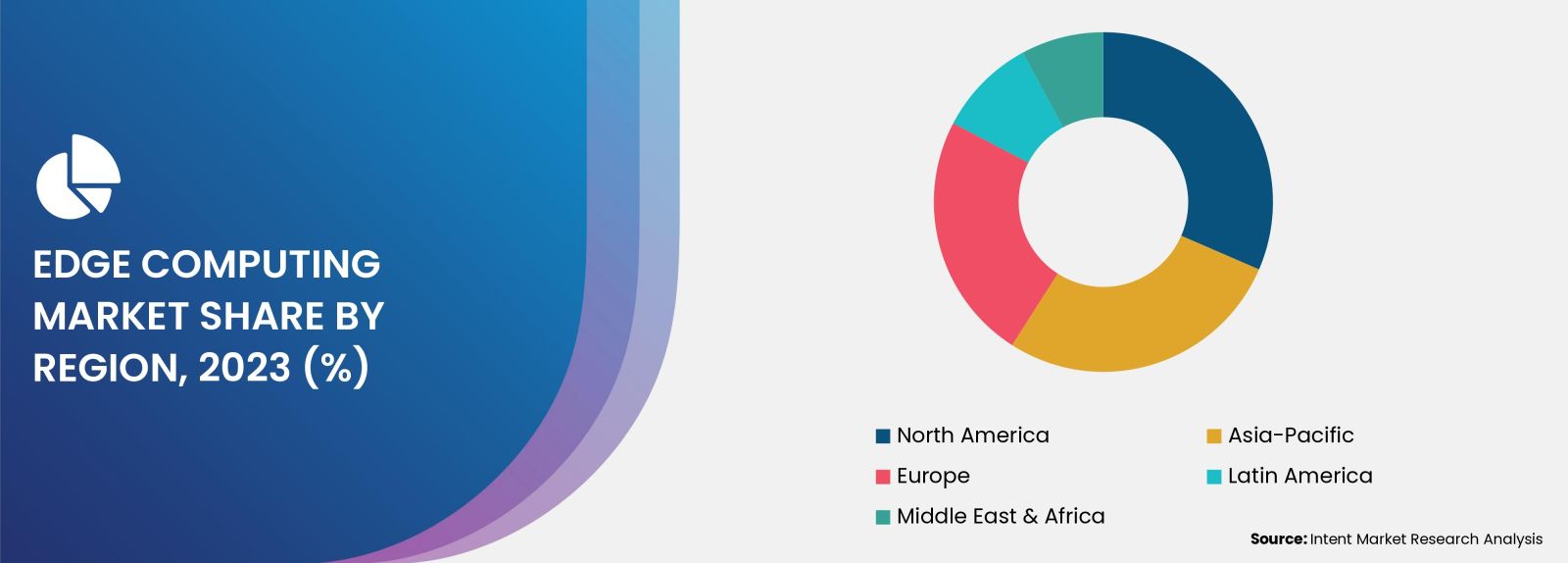
Major industry players are enhancing their market positions by adopting several growth strategies
Major players operating in the global edge computing market are AWS, Cisco, Dell, Google, HP, IBM, Microsoft, Nokia, NVIDIA, and Siemens, among others. To tap the potential share of the market, major players have started adopting strategies such as new product launches, mergers & acquisition, partnerships & collaboration. Some of the significant developments are mentioned below:
- In November 2023, AWS announced the preview of AWS IoT SiteWise Edge on Siemens Industrial Edge to help simplify, accelerate, and reduce the cost of sending industrial equipment data to the AWS cloud.
- In October 2023, Cisco unveiled the next milestone of its ongoing work with NVIDIA to deliver AI-powered meetings for hybrid workers. Cisco announced the launch of Room Kit EQX, built on the NVIDIA Jetson edge AI platform.
Edge Computing Market Coverage
The report provides key insights into the edge computing market, and it focuses on technological developments, trends, and initiatives taken by the government and private players. It delves into market drivers, restraints, opportunities, and challenges that are impacting market growth. It analyses key players as well as the competitive landscape within the global market.
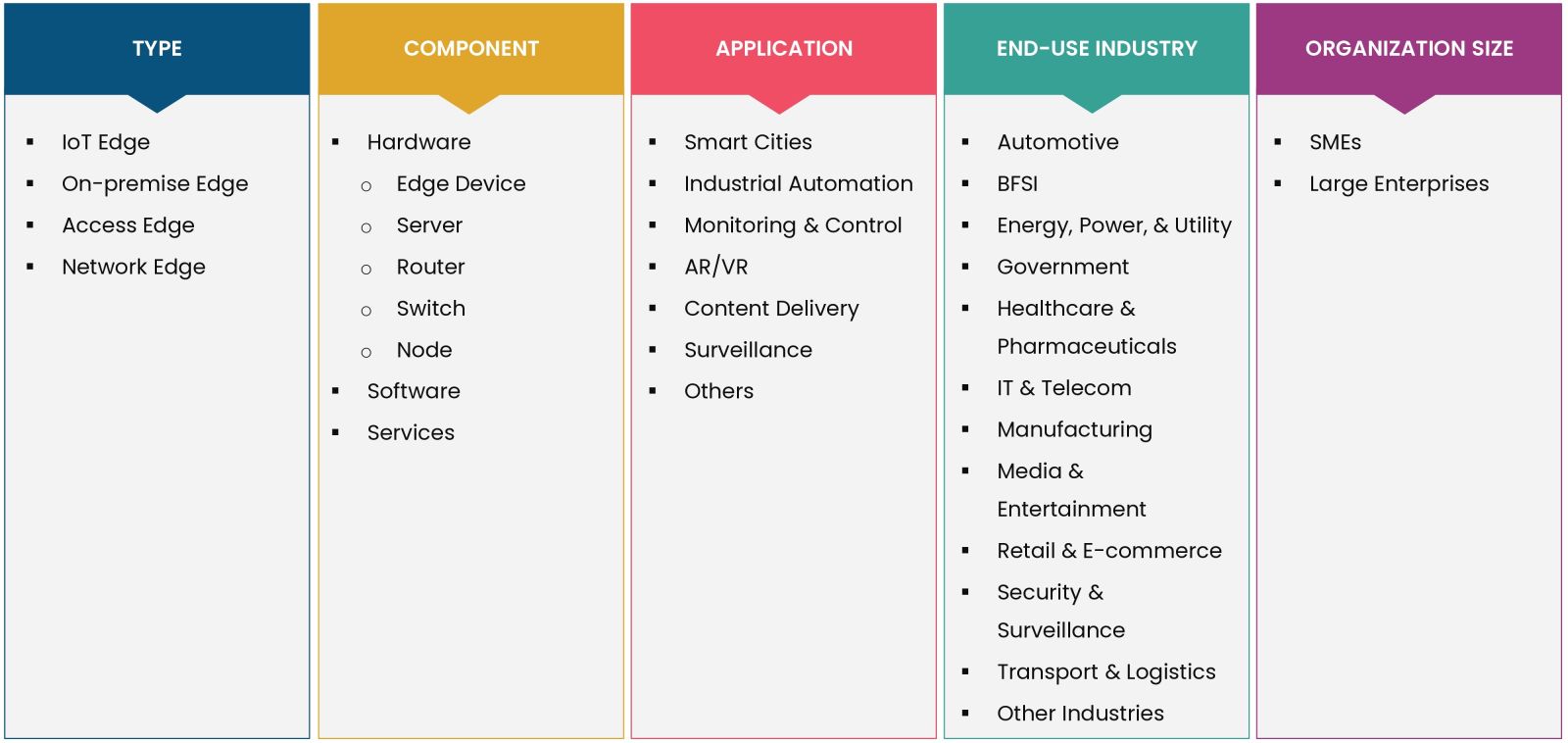
Report Scope:
|
Report Features |
Description |
|
Market Size (2023-e) |
USD 14.2 billion |
|
Forecast Revenue (2030) |
USD 116.6 billion |
|
CAGR (2024-2030) |
35.1% |
|
Base Year for Estimation |
2023-e |
|
Historic Year |
2022 |
|
Forecast Period |
2024-2030 |
|
Report Coverage |
Market Forecast, Market Dynamics, Competitive Landscape, Recent Developments |
|
Segments Covered |
By Type (IoT Edge, On-premise Edge, Access Edge, Network Edge); By Component (Hardware (Edge Device, Server, Router, Switch, Node), Software, Services); By Organization Size (SMEs, Large Enterprises); By Application (Smart Cities, Industrial Automation, Monitoring & Control, AR/VR, Content Delivery, Surveillance, Others); By End-use Industry (Automotive, BFSI, Energy, Power, & Utility, Government, Healthcare & Pharmaceuticals, IT & Telecom, Manufacturing, Media & Entertainment, Retail & E-commerce, Security & Surveillance, Transport & Logistics, Other Industries) |
|
Regional Analysis |
North America (US, Canada), Europe (Germany, France, UK, Italy), Asia-Pacific (China, Japan, South Korea, India), Latin America and Middle East & Africa |
|
Competitive Landscape |
Major Companies include AWS, Cisco, Dell, Google, HP, IBM, Microsoft, Nokia, NVIDIA, and Siemens, among others |
|
Customization Scope |
Customization for segments, region/country-level will be provided. Moreover, additional customization can be done based on the requirements. |
|
Purchase Options |
We have three licenses to opt for Single User License, Multi-User License (Up to 5 Users), Corporate Use License (Unlimited User and Printable PDF) |
|
1.Introduction |
|
1.1.Market Definition |
|
1.2.Scope of the Study |
|
1.3.Key Stakeholders of the Market |
|
2.Research Methodology |
|
2.1.Research Approach |
|
2.2.Data Collection |
|
2.3.Market Assessment |
|
2.4.Assumptions & Limitations for the Study |
|
3.Executive Summary |
|
4.Market Dynamics |
|
4.1.Drivers |
|
4.1.1.Growing Demand for Real-Time Automated Decision-Making Solutions |
|
4.1.2.Lower Data Transfer Cost |
|
4.1.3.Industry 4.0 |
|
4.2.Restraints |
|
4.2.1.High Capital Expenditure |
|
4.3.Opportunities |
|
4.3.1.Connected Car & Autonomous Vehicles |
|
4.3.2.Edge Content Delivery |
|
4.3.3.Integration with AR/VR |
|
4.4.Challenges |
|
4.4.1.Data Privacy & Security |
|
4.4.2.Limited Bandwidth |
|
4.4.3.Scalability |
|
4.5.Trends |
|
4.5.1.Real-time Analytics |
|
4.5.2.Edge-based Decision Making |
|
5.Market Outlook |
|
5.1.Pricing Analysis |
|
5.2.PESTLE Analysis |
|
5.3.PORTER's Five Forces Analysis |
|
5.4.Case Studies |
|
6.Market Segmentation by Type (Market Size & Forecast: USD Billion, 2023 – 2030) |
|
6.1.IoT Edge |
|
6.2.On-premise Edge |
|
6.3.Access Edge |
|
6.4.Network Edge |
|
7.Market Segmentation by Component (Market Size & Forecast: USD Billion, 2023 – 2030) |
|
7.1.Hardware |
|
7.1.1.Edge Device |
|
7.1.2.Server |
|
7.1.3.Router |
|
7.1.4.Switch |
|
7.1.5.Node |
|
7.2.Software |
|
7.3.Services |
|
8.Market Segmentation by Organization Size (Market Size & Forecast: USD Billion, 2023 – 2030) |
|
8.1.SMEs |
|
8.2.Large Enterprises |
|
9.Market Segmentation by Application (Market Size & Forecast: USD Billion, 2023 – 2030) |
|
9.1.Smart Cities |
|
9.2.Industrial Automation |
|
9.3.Monitoring & Control |
|
9.4.AR/VR |
|
9.5.Content Delivery |
|
9.6.Surveillance |
|
9.7.Others |
|
10.Market Segmentation by End-use Industry (Market Size & Forecast: USD Billion, 2023 – 2030) |
|
10.1. Automotive |
|
10.2. BFSI |
|
10.3. Energy, Power, & Utility |
|
10.4. Government |
|
10.5. Healthcare & Pharmaceuticals |
|
10.6. IT & Telecom |
|
10.7. Manufacturing |
|
10.8. Media & Entertainment |
|
10.9. Retail & E-commerce |
|
10.10. Security & Surveillance |
|
10.11. Transport & Logistics |
|
10.12. Other Industries |
|
11.Regional Outlook, (Market Size & Forecast: USD Billion, 2023 – 2030) |
|
11.1. North America |
|
11.1.1. US |
|
11.1.1.1. US Market Outlook by Type |
|
11.1.1.2. US Market Outlook by Component |
|
11.1.1.3. US Market Outlook by Organization Size |
|
11.1.1.4. US Market Outlook by Application |
|
11.1.1.5. US Market Outlook by End-use Industries |
|
Note: Similar Cross-segmentation for each country will be covered as shown above |
|
11.1.2. Canada |
|
11.2. Asia-Pacific |
|
11.2.1. China |
|
11.2.2. Japan |
|
11.2.3. South Korea |
|
11.2.4. India |
|
11.3. Europe |
|
11.3.1. UK |
|
11.3.2. Germany |
|
11.3.3. France |
|
11.3.4. Italy |
|
11.4. Latin America |
|
11.5. Middle East & Africa |
|
12.Competitive Landscape |
|
12.1. Market Share Analysis |
|
12.2. Key Market Growth Strategies |
|
12.3. Company Strategy Analysis |
|
12.4. Competitive Benchmarking |
|
13.Company Profile |
|
13.1. AWS |
|
13.2. Cisco |
|
13.3. Dell |
|
13.4. Google |
|
13.5. HP |
|
13.6. IBM |
|
13.7. Microsoft |
|
13.8. Nokia |
|
13.9. NVIDIA |
|
13.10. Siemens |
|
14.Appendix |
Intent Market Research employs a rigorous methodology to minimize residual errors by carefully defining the scope, validating findings through primary research, and consistently updating our in-house database. This dynamic approach allows us to capture ongoing market fluctuations and adapt to evolving market uncertainties.
The research factors used in our methodology vary depending on the specific market being analysed. To begin with, we incorporate both demand and supply side information into our model to identify and address market gaps. Additionally, we also employ approaches such as Macro-indicator Analysis, Factor Analysis, Value Chain-based Sizing, and forecasting to further increase the accuracy of the numbers and validate the findings.
Research Approach
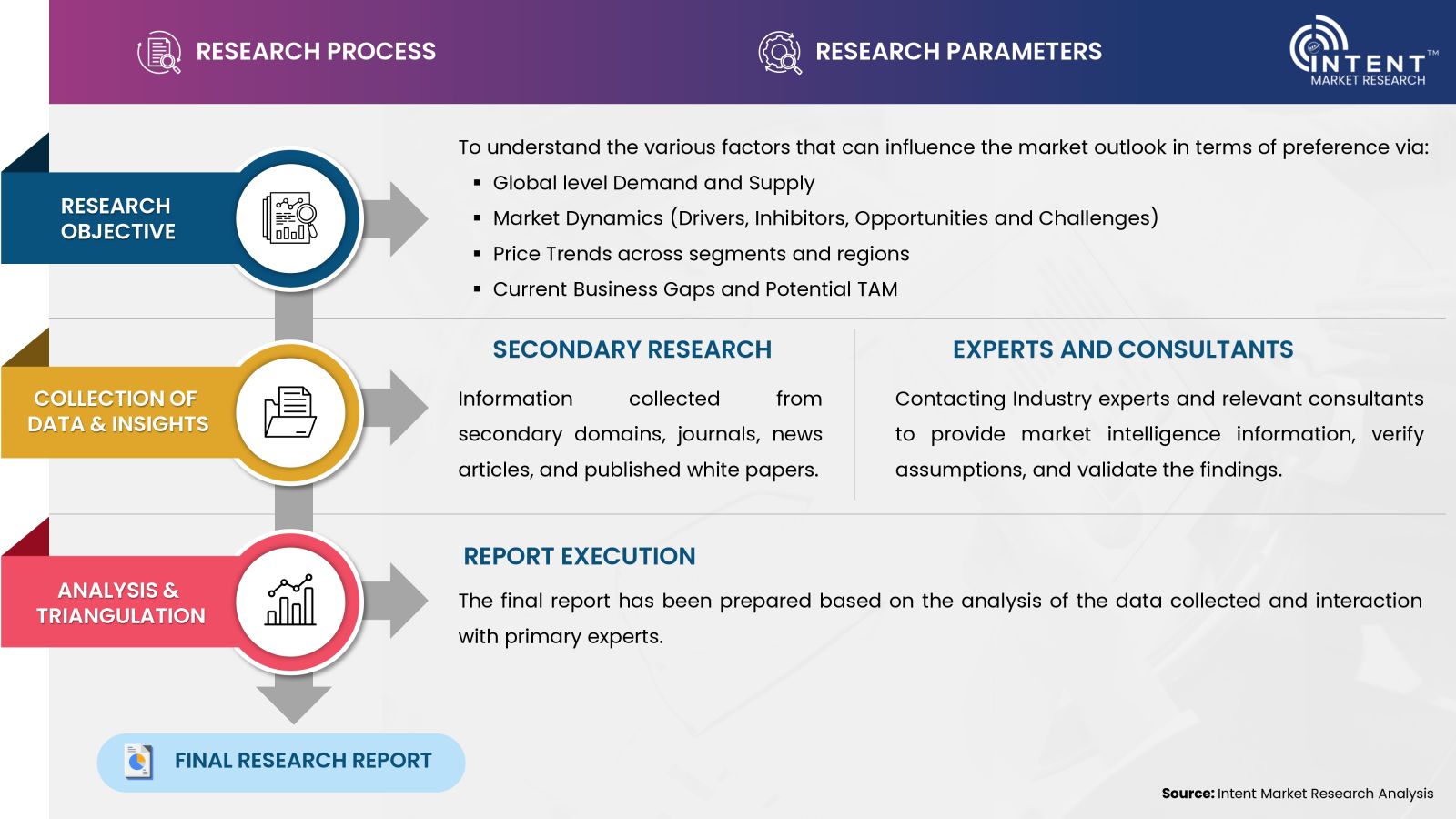
- Secondary Research Approach: During the initial phase of the research process, we acquire and accumulate extensive data continuously. This data is carefully filtered and validated through a variety of secondary sources.
- Primary Research Approach: Following the consolidation of data gathered through secondary research, we initiate a validation process to verify all the market numbers, assumptions and validate the findings by engaging with subject matter experts.
Data Collection, Analysis and Interpretation:
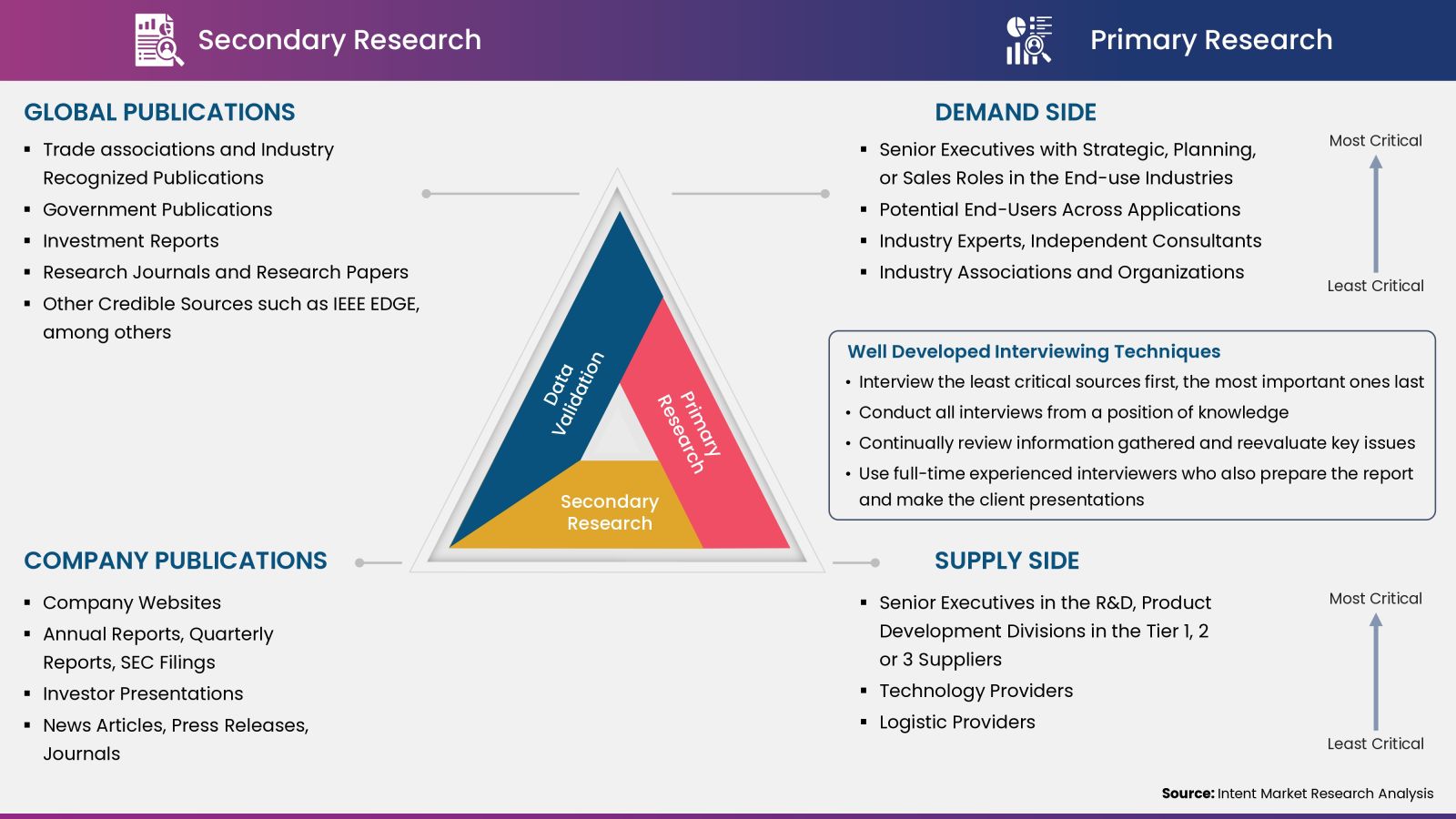
Research Methodology
Our market research methodology utilizes both top-down and bottom-up approaches to segment and estimate quantitative aspects of the market. We also employ multi-perspective analysis, examining the market from distinct viewpoints.
